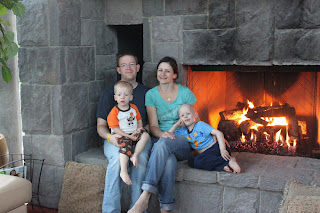
Ever since
Brayden was diagnosed with Ewing's Sarcoma in January, we have been trying to find time to steal away a visit to the
Children's Cancer Association's Alexandra Ellis Caring Cabin in Pacific City, Oregon. It's been harder than expected to do. Brayden's chemotherapy schedule is aggressive, starting every 2 weeks and there just hasn't been an available weekend at the Cabin that Teresa and I could find that would work between hospital visits.
On July 12th, we learned the Cabin would be available from the 23rd to the 26th, due to some last minute changes. So we left our house not knowing what to expect, but hopeful for some time dedicated to family fun and reflection on these past 7 months.
It is awesome to witness what people can do as a result of great tragedy, and the CCA organization has created an incredible facility to help families going through this terrible experience. Rooms are stuffed with toys and books, large spaces to eat and gather, packed with art that both sparks a child's imagination and grabs a parent's heart. What an amazing place!
Some friends joined us for the first few days and helped the kids explore the grounds.

And then took a few days to ourselves, spending extra time reading books by the fire, trying to be a normal family again.
Pacific City happens to have one of our favorite beaches in Oregon and the Cabin is only a 3 minute drive from our preferred access road (just north of Cape Kiwanda).
We've played here before;
camping, exploring this same beach. But this was different. This time, while Brayden played on the beach below,

I helped my 7-yr old nephew Alex explore the top of the same cape Brayden and I climbed when
he was only 2.

Noah enjoys playing in the sand as much as his big brother now does

and being "goofy Noah" comes very naturally.

We killed the battery in our truck and Dave got his stuck in the sand. Luckily, someone drove by and helped us jump start our vehicle and pull his out of the sand. Unfortunately the ocean wasn't about to give up, and sent a sneaker wave that filled the vehicle with Salt Water!

Back at the cabin, we tried to make the most of it.


Everyone really enjoying the deck overlooking the little pond during morning coffee, snacks, meal time etc.
The kids enjoyed just being kids,
On a last minute whim, we were able to rent a small dune buggy from Sand Lake Tsunami to explore nearby Sand Lake for an hr or so. You can't tell with the helmets and goggles, but Brayden, sitting next to me in the front, has an ear-to-ear grin. Even cautious Noah would shake his whole helmeted head up-and-down when we'd turn and ask him "More"?
It was a fun time, and the boys and I were able to get some much needed sleep.
Just before we packed up to come back to Portland, we walked down the winding path to the pond.
This path is lined with stones, engraved with names of children who have stayed here before.

Brayden was able to leave a stone behind with his name too.

We would never have chosen to be eligible to visit this place, but such choices lie outside our control. What we do realize even more clearly today is the need to make the most of the times we have.

Thank you CCA for enabling us to have such a wonderful, memorable weekend.
 they were eating lunch in the park by mid-day.
they were eating lunch in the park by mid-day. Lego's have become a major part of this past year's entertainment, and the kids were anxious to explore the many amazing creations.
Lego's have become a major part of this past year's entertainment, and the kids were anxious to explore the many amazing creations.

 The rides at Lego land are geared towards the younger crowd (e.g. 8 an under), so our two boys found many options to choose from.
The rides at Lego land are geared towards the younger crowd (e.g. 8 an under), so our two boys found many options to choose from.


 The favorite rides were the roller coasters, the "Coastersaurus" and Technic Project X.
The favorite rides were the roller coasters, the "Coastersaurus" and Technic Project X. Brayden rode Technic at least 3 times.
Brayden rode Technic at least 3 times.

 Brayden's favorite rides were Space Mountain and Big Thunder Mountain Railroad. Noah loved the Pixar parade.
Brayden's favorite rides were Space Mountain and Big Thunder Mountain Railroad. Noah loved the Pixar parade.


 We were able to enjoy the Christmas decorations that Disney does this time of year. The "It's a Small World" ride was another one of the favorites. Didn't realize it goes through a conversion each year for Christmas time, and they change the song to sing Christmas carols. Heres a video, I apologize in advance if the tune get's stuck in your head :(
We were able to enjoy the Christmas decorations that Disney does this time of year. The "It's a Small World" ride was another one of the favorites. Didn't realize it goes through a conversion each year for Christmas time, and they change the song to sing Christmas carols. Heres a video, I apologize in advance if the tune get's stuck in your head :(






































